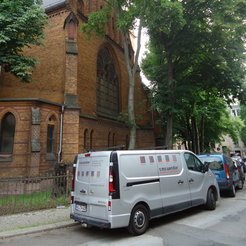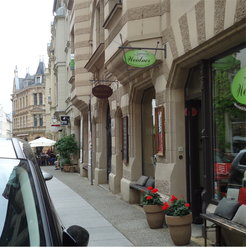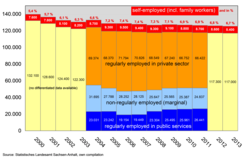Fieldwork at home: first impressions about self-employment in Halle
Author: Sylvia Terpe
July 6, 2016
When our PhD-students in the REALEURASIA-project left Halle, the home location of our institute, in late summer 2015, I felt a small sting of envy. While they (as anthropologists) would go to distant places and feel the excitement of the new, I (as the sociologist in the project) would stay in Halle, a city in the middle of East Germany on the river Saale - which is at the same time my home town. However, doing fieldwork on one’s doorstep has its own fascination: it allows one to look anew at the familiar and to question what seems to be self-evident. Besides, the project’s focus on small businesses would connect me to a realm of city life which I had thus far only known as a customer. Therefore, I was keen to start my fieldwork in February 2016 and to learn more about the perceptions, concerns, and pleasures of self-employed people in Halle.
It is useful to preface my first impressions with some information about Halle's long past which is closely connected with harvesting and trading salt. In the 15th century the so called Halloren, who were salt workers, founded a brotherhood, the Salzwirker-Brüderschaft. This brotherhood still exists, nowadays as an association that is concerned with maintaining the tradition of salt production in public memory. However, one of my interviewees, who is a member in the brotherhood, also emphasized its usefulness for obtaining helpful information and sometimes even orders for his business. This interesting mixture between value orientations and instrumental considerations for being a member of such a network will be a topic of further analysis - also because roughly one third of my (currently) 42 interviewees mentioned such networks. Some are more institutionalized than others (e.g. the guilds contrast with more informal networks), some of them have a longer history (like the Rotary Club with its explicit self-description as a "value community"), while others seem to be modern and to some extent the functional equivalents of previous structures. For instance, several interviewees mentioned regular "training courses" offered by firms whose products they use or sell, where they meet people with similar businesses with whom they, as one interviewee said, "cooperate and compete" at the same time.
In the 16th century, Halloren and Pfänner, who were owners of the salt pans, developed into a self-assured citizenry and a conflict with Cardinal Albrecht von Brandenburg ensued. This Albrecht von Brandenburg, who chose Halle as his favourite residence, was not only famous for his ostentatious lifestyle and display of wealth. Several legends regarding his mistresses and his special relation to religious symbols were also passed down. According to one legend, he grieved when his beloved Magdalena, the daughter of a baker, was dying at a very young age. So he commissioned a painting showing the Mother of God, Mary, with Magdalena’s face. It is said that this painting was incorporated into the altar of the old Marienkirche, the church on Halle’s market place that was later replaced by the more celebrated Marktkirche during Albrecht’s life-time.
Whatever aroused the indignation of Halle’s citizenry against Albrecht, their protest was supported by Martin Luther, who was born in a small town nearby. Luther preached several times in Halle’s Marktkirche and it is reported that his anger at Albrecht von Brandenburg (whose agent Johann Tetzel sold indulgences in order to settle Albrecht’s heavy debts to the Fuggers) motivated him to write his 95 Theses. Nowadays, the local university is called Martin-Luther-Universität Halle-Wittenberg, which emphasizes Halle’s connection to Wittenberg, the cradle of Protestant Reformation.
However, religion does not seem to play a very prominent role in Halle any more. According to official statistics, only 20 per cent of Halle’s inhabitants belong to a religious denomination, half of them to the Lutheran church. A representative survey conducted in 2012 shows that around 5 per cent of non-members believe in God and almost 18 per cent believe in "some sort of spirit or life force".

However, the same survey indicates that 20 per cent of registered church members cannot be regarded as believers, because they either "don't really know what to believe" or because they "don't really think that there is any sort of spirit, God or life force". These figures correspond to my first experiences in the field. Only two of my interviewees brought up the topic of religion on their own, several described themselves in the questionnaire as (somewhat) "religious" or "spiritual", but without belonging to a church, a few others specified that they were members of a denomination, but not actually "religious" or "spiritual" at all. Hence, in the forthcoming analysis and further interviews I will not only focus on the meanings of religiosity but also try to uncover what it means to be "not religious". It is comparatively rare that non-religiosity takes the shape of a strong, reflected, and elaborate atheism. The majority of my interviewees rather regard it as 'just normal' not to be religious - so my task is to understand exactly this areligious normalcy.
The low level of religiosity in Halle is certainly a heritage of the socialist GDR period. While German reunification does not seem to have changed much in relation to religion, the city has undergone many other transformations since then. In 1990, Halle had around 300 000 inhabitants, due to the unification of the old city of Halle with the new town of Halle-Neustadt, which was built since the late 1960s on the doorstep of Halle as an autonomous city. Although Halle-Neustadt was mainly planned to house workers of the nearby chemical sites of Buna and Leuna, it was a favoured neighbourhood for other people too. The equipment of the flats was very modern for its time and each larger housing complex had a good infrastructure with kindergartens, schools, playgrounds, a supermarket (Kaufhalle), a health care centre (Poliklinik) and restaurants and cafes. While this project of a socialist city was developed in the 70s and 80s, the buildings of the old town were neglected; coal-burning stoves, cold water and toilets outside the flat were still common. Other houses in the old town were too dilapidated to be inhabited anymore; reunification came just in time to save them.
Since then, large parts of the old town have been restored and are favoured residential areas today. Although these reconstructions and renovations are appreciated by Halle’s inhabitants in general, they did not occur without conflict. In many cases money came from previous owners and investors from West Germany, who reclaimed former houses or bought new property, displacing long-time residents and people who could not afford higher rents. A typical memory of the early 90s in Halle’s old town mentioned by an interviewee is that of a Wessi (disparaging term for a person from West Germany) with a big car taking photographs of the building he is about to buy. The 90s were characterized by a construction boom and simultaneous segregation processes, marginalizing large parts of the poorer strata to Halle-Neustadt and Silberhöhe, another socialist Plattenbau area.
My interviewees often refer to the GDR era and to German reunification. Some of them highlight the constraints and difficulties they faced during GDR times, but also the fact that they belonged then to a minority that was much in demand, due to the shortages characteristic of the state-owned sector. It surprised me to hear that the satisfying experience of being much sought-after is again relevant for some self-employed, in particular for those in the construction sector. While in the 2000s this industry was characterized by predatory price-cutting competition, the flow of orders nowadays appears to be fairly good. Prices, however, seem to recover only slowly. My interviewees emphasize other benefits of this development, such as the option to reject orders for unpopular jobs or from customers who are perceived as "arrogant and complicated" or whose solvency is uncertain.

Despite the healthy order situation, these firms in the construction sector of my sample do not consider expansion: on the one hand, they bemoan a shortage of well-trained and skilled workers; on the other hand, they do not seem to be confident that the healthy order situation will continue. The hard times of the 2000s are still fresh in their memory and firm owners do not want to run the risk of having too many workers on their payrolls.
Compared with the self-employed in the construction sector, the economic situation of interviewees who are small retailers or service providers without employees is not promising and at times even precarious. They often address competition either with larger firms or with corporations from West Germany or from 'the Internet' as their main problem; some of them also deplore the fact that purchasing power in Halle is so low.


For these small business owners, being supported materially by their partners (spouses or boy- or girl-friends) is often essential. More than once I was told that they would not be able to remain self-employed without the regular income earned by their partner (either as an employee or as self-employed in a more prosperous business). It will be interesting to explore the effects of such dependencies on one's work ethic and other issues - not least because they contrast with the freedom that is commonly associated with self-employment.
Regardless of economic position, sectoral branch or company size, some topics came up over and over again during the interviews. One such was the contrast between being self-employed and being an employee. Although the latter is mostly associated with a secure (but not necessarily high) income, it has different connotations. In one meaning, this security is perceived as the price for not being free, for dependence on a nasty boss or for being wedged in a bureaucratic organizational setting. In another meaning, the security of an employee’s income is associated with a low work ethic, e.g. doing one’s job solely on the basis of the instructions received and without inner commitment. That does not mean, of course, that the work ethic of the self-employed is only constructed via such pejorative distinctions, but deeper analysis is necessary in order to reveal further dimensions. In any case, positive or negative distinctions vis-à-vis employees are a recurrent theme, as is the work ethic. One reason for this might be that self-employment in Halle is still fairly rare. Indeed, with a proportion of 6.7 per cent (in 2013) the self-employed are a small minority of Halle’s working population and many of my interviewees seemed to be conscious of their exceptional status.

When asked about reasons for low self-employment, my interviewees mentioned legal and other constraints, they complained about unjust tax rates and about a political rhetoric which emphasizes the importance of the German Mittelstand, but which fails to address the problems of small business owners. Many emphasized how their self-employment affects their families, their leisure time and at times even their health. Although these topics are significant for almost all the self-employed persons with whom I talked, individuals reacted quite differently to these adversities: the spectrum ranged from a resigned acceptance of seemingly immutable working conditions to different individual strategies of coping and various forms of collective engagement. It will be an exciting task to make sense of these reactions in the coming months.




